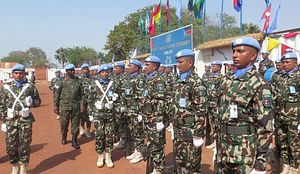In general practice, small powers are less likely to engage in military diplomacy as it is generally believed that the military is the tool of powerful states. However, Nepal, though a small state, has been closely involved in military issues for centuries.
The Rana dynasty, which ruled Nepal from 1846-1951, had deep ties with the British and in 1857-58 helped the British suppress the Sepoy Mutiny in India. Nepal later aided the Younghusband expedition to Tibet in 1903-1904 and assisted the British government during the World Wars. This long history established military diplomacy as a major technique for Nepal’s diplomatic relations, which also brought Nepal closer to its southern neighbor.
Nepalis have a long history of engaging in foreign battles and working as a mercenary force for foreign powers. In particular, Nepal’s Gurkhas are renowned for their martial culture around the world. However, joining the military is attractive for Nepalis mostly due to the hardship and poverty they face at home. Many enlist, whether for Nepal or a foreign country, in order to escape.
The term “Gurkha” is derived from the kingdom of the Gorkhas, who conquered Nepal and other Himalayan states; however, the ethnic communities that serve in the Gurkha army have little to do with this historic state. Generally, four ethnic groups — the Magar, Gurung, Rai, and Limbu — are considered the top choices for recruitment. As a result, some members of other ethnic groups have changed their family name to boost their chances of getting in the army.
The Nepali army is a contributor to UN peacekeeping missions; in fact, many youths in Nepal join the army in the hope of having a short stint on a well-paying UN mission. Apart from serving in Britain, India, and in the UN missions, Gurkhas of Nepal till this day also serve in the Singapore Police as the Gurkha Contingent and in Brunei as the Gurkha Reserve Unit.
Historically, Nepal’s relations with its neighbors were determined because of war and military affairs. Now there are changing winds in Nepal’s military diplomacy. More than ever before, Nepal is increasing its military outreach to China.
In 1989, India imposed a blockade on Nepal, which was then ruled by the autocratic Panchayat regime. The real reason for the blockade was that the government of Nepal had purchased weapons from China. Within a few years the Panchayat regime fell apart and multiparty democracy was installed in Nepal. In 2005, Nepal’s King Gyanendra had also purchased weapons from China — a few years later he was deposed and Nepal was turned into a republic. Clearly, Nepal’s efforts to enhance military relations with China have always sparked India’s concerns, as New Delhi bitterly remembers the 1962 Sino-Indian war.
Those governments of Nepal seen as a threat by India have historically not lasted long. But this changed after the 2015 Indian blockade, when average Nepalis were greatly affected by Indian interference in the internal issues of Nepal. The Communist Party of Nepal-United Marxist Leninist, which was running the government at the time of the blockade, benefitted from a boost in public support. It became the largest part of Nepal after the 2017 elections, and thanks to party unification with the third largest party, the Maoists, the rebranded Communist Party of Nepal holds a nearly two-thirds majority in the parliament. The stage is now set for the previously taboo: military ties with China.
Nepal still continues to conduct joint military drills with India, with the latest being Surya Kiran XIII, which was held June 2018. But Nepal has also started military drills with China, with gives an entirely new image to Nepal’s military diplomacy. In fact, Nepal recently backed out from a new joint military exercise in India planned for BIMSTEC states but continued its military drill with China, which started on September 17 in Sichuan province.
Those twin decisions may contribute to cooling relations between Nepal and India. The Indian media was quick to notice that Nepal backing out from the joint military drill with India, its largest trading partner, came just as Nepal signed a protocol to be able to use Chinese ports for trans-shipment.
There may be a sense of distaste in the Indian military for the changing status quo; Indian Army Chief General Bipin Rawat remarked that Nepal and Bhutan “will have to be with India due to the geographical conditions.” However, China’s Belt and Road Initiative may be working to break physical barriers that have existed for centuries.
In addition to the new military exercise with China, Nepal’s Armed Police Force continues to receive assistance from China meant to protect both countries from unwanted activities along their shared border. In the past, Nepal’s purchases of weapons from China deeply affected India, which caused regime changes in Nepal. Today, Nepal’s military diplomacy with China may strain Indo-Nepal relations.
If China supports Nepal in increasing its presence in UN peacekeeping missions and continues to assist Nepal in upgrading its security forces while providing training to the military as well as police officials, this may indeed deepen the relationship between the two countries. More subtly, economic growth may help to wean Nepal’s youth from their desire to work for a foreign army — only then can it be sure that young Nepalis will not be recruited as soldiers in a war against China, as happened in the Boxer Rebellion era.
Kripendra Amatya is a Nepal native and a graduate in international relations from Jilin University, China.

































